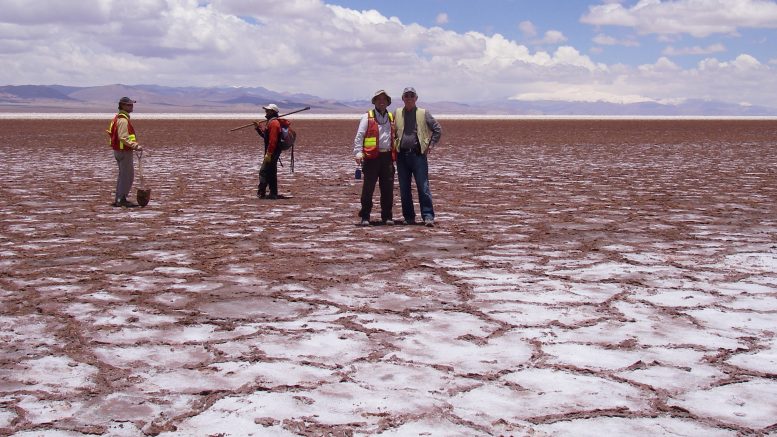Metals and minerals for rechargeable batteries are in the spotlight as projections of rapidly increasing demand indicate future supply shortages. Over the next 10 years, demand for lithium and cobalt is expected to more than double, and graphite demand is expected to triple. Vanadium, manganese, nickel and rare earth elements are also needed in rechargeable batteries.
Against this background of anticipated demand growth, technology is changing at a furious pace in the battery sector as manufacturers are challenged to improve performance. For example, electric-vehicle battery manufacturers face intense pressure to boost charge capacity, shorten recharging time, lighten weight, improve cold weather performance and safety, and cut costs.
To realize these performance advancements, manufacturers are demanding improved quality and processing efficiency from their lithium, cobalt and graphite feedstock suppliers.
These demands take on a new dimension when considering specialty mineral deposits, which differ from base and precious metal deposits in that their economic viability is affected by factors such mineralogy, chemical purity and the nature of any impurities, and not just the resource tonnage and grade.
For instance, the crystal structure of mined graphite appears in the final battery. This is not the case for metals such as cobalt, which are leached from their native minerals and take on new crystal structures in a battery. In the case of both graphite and lithium, the specifics of the deposit will determine a miner’s ability to economically produce battery-grade materials.
Because the physical, chemical and mineralogical aspects of the deposit are so critical to meet the quality demands of the market, we recommend investigative metallurgical tests early in any exploration program. Early investigation of mineralogy and chemical composition will also help identify potential markets — information that can then be integrated into a larger exploration program to provide better focus and potentially save money.
When calculating an initial resource estimate, this early test work may also support a case that the deposit is potentially economic at a suitable product price.
Market studies are an important aspect of specialty mineral projects because these markets are opaque, trade occurs directly between seller and buyer, and transaction prices are rarely published. Furthermore, product specifications are often proprietary, adding another layer of market opacity.
Lithium, cobalt & graphite
Lithium resources occur as brines in salars (salt lakes) and in hard rock as the minerals spodumene, petalite, lepidolite and mica, and to a lesser extent, in lithium-bearing clays. Lithium brines are concentrated using solar evaporation and processed to recover the principal battery chemicals lithium carbonate and lithium hydroxide. Hard-rock lithium minerals must be physically beneficiated to produce a mineral concentrate that is processed by calcination and acid leaching, after which the leach solutions are treated to recover lithium carbonate or hydroxide.
Lithium hydroxide is gaining use in batteries which have a higher nickel content, since the carbonate may cause passivation of the nickel during manufacturing of the cathode alloy. Several hydrometallurgical processes are under development that will produce lithium hydroxide directly without going through the carbonate stage. These processes promise to lower energy and reagent consumption and achieve even higher purity, considering that impurities often must be in the parts-per-million range.
However, these innovations can’t be implemented immediately, as they first need to be scaled up and prove their commercial viability. This commercialization phase can take several years, so proven technology will likely remain the first choice for participants looking to gain market share and capitalize on any short-term supply problems.
Cobalt resources are widespread but the metal is mostly recovered as a by-product of nickel or copper mining, with just one primary source.
There is a complex relationship between battery chemistry and performance: cobalt hydroxide is used in nickel-cadmium and nickel-metal-hydride batteries for portable electronics and electric vehicles; cobalt oxide is used in lithium-cobalt oxide batteries for consumer electronics; and cobalt sulphate is mainly used in lithium-nickel-cobalt-alumina and nickel-manganese-cobalt batteries for electric vehicles and power tools.
As for lithium battery chemicals, battery-grade cobalt sulphate specifications may require certain impurities in the parts-per-million range, particularly iron, copper, lead and cadmium.
Graphite is naturally abundant but has economic interest when it occurs as lenses, layers or veins of microcrystalline masses (termed amorphous) or discrete crystalline flakes between 75 and 850 microns in size, or in more lumpy particles.
For battery applications, both synthetic and natural graphite may be used, but synthetic graphite is derived from hydrocarbons using energy intensive processes, and so natural deposits of graphite usually offer cost advantages.
Natural graphite is liberated and concentrated using multiple stages of conventional flotation to produce a high-purity concentrate that is processed into a spherical product, and further refined to produce battery-grade material.
Recent developments in graphite processing have focused on micronizing, spherodizing and purification. The spherodization process folds and wraps each graphite flake into a sphere, also known as a “potato.” This allows the graphite to be efficiently packed within the anode while, at the same time, allowing rapid passage of lithium ions.
The challenge today in beneficiation is to achieve purity through liberation of the graphite flakes while maintaining the flake size and aspect ratio, such that the final sphere can be produced with sufficient size and with total final impurities less than 0.05%. TNM
— Aron Cleugh, P.Eng., MBA, is managing director of M.Plan International and an extractive metallurgist specializing in hydrometallurgy, comminution and process development. He has nearly 20 years of experience in operations and with major engineering firms, and has worked on detailed engineering and project development studies for a variety of metals and minerals in Canada and internationally.
Reiner Haus, PhD, MBA, is co-chairman of M.Plan International and managing director of M.Plan’s German shareholding company Dorfner Analysenzentrum und Anlagenplanungsgesellschaft mbH (Anzaplan). A geological engineer by training, he has extensive knowledge of the production and processing of specialty minerals and metals.
Jane Spooner, M.Sc., P.Geo., is co-chairman of M.Plan International and a vice-president of M.Plan’s shareholding company, Micon International Limited. Trained as a geologist, she specializes in mineral economics and marketing for specialty minerals and metals.
Toronto-based M.Plan International Ltd. is a joint venture formed by Germany’s Dorfner Anzaplan and Canada’s Micon International to provide an integrated suite of services to the specialty minerals and metals sector. Visit mplaninternational.com for more information.





Excellent article – very informative overview of the new energy battery metals with an emphasis on the ‘processing importance’, for example, of lithium, graphite, vanadium, etc, to enhance the end result efficiencies of the critical battery metals (energy density, charging time, safety, etc).